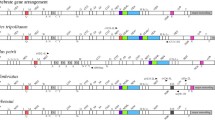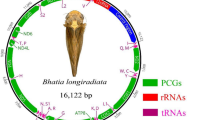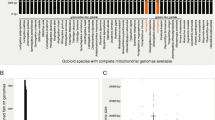Abstract
Complete sequence determination of the mitochondrial (mt) genome of the sea scallop Placopecten magellanicus reveals a molecule radically different from that of the standard metazoan. With a minimum length of 30,680 nucleotides (nt; with one copy of a 1.4 kilobase (kb) repeat) and a maximum of 40,725 nt, it is the longest reported metazoan mitochondrial DNA (mtDNA). More than 50% of the genome is noncoding (NC), consisting of dispersed, imperfectly repeated sequences that are associated with tRNAs or tRNA-like structures. Although the genes for atp8 and two tRNAs were not discovered, the genome still has the potential for encoding 46 genes (the additional genes are all tRNAs), 9 of which encode tRNAs for methionine. The coding portions appear to be evolving at a rate consistent with other members of the pectinid clade. When the NC regions containing “dispersed repeat families” are examined in detail, we reach the conclusion that transposition involving tRNAs or tRNA-like structures is occurring and is responsible for the large size and abundance of noncoding DNA in the molecule. The rarity of enlarged mt genomes in the face of a demonstration that they can exist suggests that a small, compact organization is an actively maintained feature of metazoan mtDNA.







Similar content being viewed by others
References
Altschul S, Gish W, Miller W, Myers E, Lipman D (1990) Basic local alignment search tool. J Mol Biol 215:403–410
Attardi G (1985) Animal mitochondrial DNA: an extreme example of genetic economy. Int Rev Cytol 93:93–145
Avise JC (2000) Phylogeography: the history and formation of species. Harvard University Press, Cambridge, MA
Beagley CT, Macfarlane JL, Pont-Kingdon GA, Okimoto R, Okada N, Wolstenholme DR (1995) Mitochondrial genomes of Anthozoa (Cnidaria) In: Palmieri F, Papa S, Saccone C, Gadaleta N (eds) Progress in Cell Research—Symposium on Thirty Years of Progress in Mitochondrial Bioenergetics and Molecular Biology (F). Elsevier, Amsterdam, pp 149–153
Benson G (1999) Tandem repeats finder: a program to analyze DNA sequences. Nucleic Acids Res 27:573–580
Boore JL (1999) Animal mitochondrial genomes. Nucleic Acids Res 27:1767–1780
Boore JL, Brown WM (1998) Big trees from little genomes: mitochondrial gene order as a phylogenetic tool. Curr Opin Genet Dev 8:668–674
Boore JL, Medina M, Rosenberg LA (2004) Complete sequences of the highly rearranged molluscan mitochondrial genomes of the scaphopod Graptacme eborea and the bivalve Mytilus edulis. Mol Biol Evol 21:1492–1503
Boyce TM, Zwich ME, Aquadro CF (1989) Mitochondrial DNA in the bark weevils: size, structure and heteroplasmy. Genetics 123:825–836
Burnzynski A, Zbawicka M, Skibinski DOF, Wenne R (2003) Evidence for recombination of mtDNA in the marine mussel Mytilus trossulus from the Baltic. Mol Biol Evol 20:388–392
Daniels GR, Deininger PL (1985) Repeat sequence families derived from mammalian tRNA genes. Nature 317:819–822
DeJong R, Emery AM, Adema CM (2004) The mitochondrial genome of Biomphalaria glabrata, intermediate host of Schistosoma mansoni. J Parasitol 90:991–997
Eberhard JR, Wright TF, Bermingham E (2001) Duplication and concerted evolution of the mitochondrial control region in the parrot genus amazona. Mol Biol Evol 18:1330–1342
Endo K, Noguchi Y, Ueshima R, Jacobs HT (2005) Novel repetitive structures, deviant protein-encoding sequences and unidentified ORFs in the mitochondrial genome of the brachiopod Lingula anatina. J Mol Evol 61:36–53
Fuller K, Zouros E (1993) Dipsersed discrete length polymorphism of mitochondrial DNA in the scallop Placopecten magellanicus (Gmelin). Curr Genet 23:365–369
Galli G, Hofstetter H, Birnstiel ML (1981) Two conserved sequence blocks within eukaryotic tRNA genes are major promoter elements. Nature 294:626–631
Gjetvaj B, Cook DI, Zouros E (1992) Repeated sequences and large-scale size variation of mitochondrial DNA: a common feature among scallops (Bivalvia: Pectinidae). Mol Biol Evol 9:106–124
Hoffmann RJ, Boore JL, Brown WM (1992) A novel mitochondrial genome organization for the blue mussel, Mytilus edulis. Genetics 131:397–412
Hoarau GS, Holla R, Lescasse W, Stam T (2002) Heteroplasmy and evidence for recombination in the mitochondrial control region of the flatfish Platichthys flesus. Mol Biol Evol 19:2261–2264
Jacobs HT, Asakawa W, Araki T, Miura K, Smith MJ, Watanabe K (1989) Conserved tRNA gene cluster in starfish mitochondrial DNA. Curr Genet 15:193–206
Janke A, Pääbo S (1993) Editing of a tRNA anticodon in marsupial mitochondria changes its codon recognition. Nucleic Acids Res 21:1523–1525
Kim SH, Je EY, Park DW (1999) Crassostrea gigas mitochondrial DNA. GenBank accession number AF177226
Kimura M (1980) A simple method for estimating evolutionary rate of base substitutions through comparative studies of nucleotide sequences. J Mol Evol 16:111–120
Kurtz S, Choundhuri JV, Ohlebusch E, Schleiermacher C, Stoye J, Giegerich R (2001) The manifold applications of repeat analysis on a genomic scale. Nucleic Acids Res 29:4633–4642
Kyte J, Doolittle RF (1982) A simple method for displaying the hydrophobic character of a protein. Mol Biol 157:105–142
Ladoukakis ED, Zouros E (2001a) Direct evidence for homologous recombination in mussel (Mytilus galloprovincialis) mitochondrial DNA. Mol Biol Evol 18:1168–1175
Ladoukakis ED, Zouros E (2001b) Recombination in animal mitochondrial DNA: evidence from published sequences. Mol Biol Evol 18:2127–2131
LaRoche J, Snyder M, Cook DI, Fuller K, Zouros E (1990) Molecular characterization of a repeat element causing large-scale size variation in the mitochondrial DNA of the sea scallop Placopecten magellanicus. Mol Biol Evol 7:45–64
Lemieux C, Otis C, Turmel M (2000) Ancestral chloroplast genome in Mesostigma viride reveals an early branch of green plant evolution. Nature 403:649–652
Levinson G, Gutman GA (1987) Slipped-strand mispairing: a major mechanism for DNA sequence evolution. Mol Biol Evol 4:203–221
Lowe TM, Eddy SR (1997) tRNAscan-SE: a program for improved detection of transfer RNA genes in genomic sequence. Nucleic Acids Res 25:955–964
Lunt DH, Hyman BC (1997) Animal mitochondrial DNA recombination. Nature 387:247
Mizi A, Zouros E, Moschonas N, Rodakis GC (2005) The complete maternal and paternal mitochondrial genomes of the Mediterranean mussel Mytilus galloprovincialis: implications for the doubly uniparental inheritance mode of mtDNA. Mol Bio Evol 22:952–967
Ojala D, Merkel C, Gelfand R, Attaridi G (1980) The tRNA genes punctuate the reading of genetic information in human mitochondrial DNA. Cell 22:393–403
Okazaki M, Ueshima R (2001) Evolutionary diversity between the gender-associated mitochondrial DNA genomes of freshwater mussels. GenBank accession numbers AB055624 (male haplotype) and AB055625 (female haplotype)
Piganeau G, Gardner M, Eyre-Walker A (2004) A broad survey of recombination in animal mitochondria. Mol Biol Evol 21:2319–2325
Rand D (1993) Endotherms, ectotherms, and mitochondrial genome-size variation. J Mol Evol 37:281–295
Robinson-Rechavi M, Huchon D (2000) RRTree: relative-rate tests between groups of sequences on a phylogenetic tree. Bioinformatics 16:296–297
Rubio MA, Ragone FL, Gaston KW, Ibba M, Alfonzo JD (2006) C to U editing stimulates A to I editing in the anticodon loop of cytoplasmic threonyl tRNA in Trypanosoma brucei. J Biol Chem 281:115–120
Serb JM, Lydeard C (2003) Complete mtDNA sequence of the North American freshwater mussel, Lampsilis ornate (Unionidae): an examination of the evolution and phylogenetic utility of mitochondrial genome organization in bivalvia (Mullusca). Mol Biol Evol 20:1854–1866
Snyder M, Fraser AR, LaRoche J, Gartner-Kepkay KE, Zouros E (1987) Atypical mitochondrial DNA from the deep-sea scallop Placopecten magellanicus. Proc Natl Acad Sci USA 84:7595–7599
Thompson JD, Higgins DG, Gibson TJ (1994) Clustal W: improving the sensitivity of progressive multiple sequence alignment through sequence weighting, position-specific gap penalties and weight matrix choice. Nucleic Acids Res 22:4673–4680
Thyagarajan B, Padua RA, Campbell C (1996) Mammalian mitochondria possess homologous DNA recombination activity. J Biol Chem 271:27536–27543
Tsaousis AD, Martin DP, Ladoukakis ED, Posadaand D, Zouros E (2005) Widespread recombination in published animal mtDNA sequences. Mol Biol Evol 22:925–933
Turmel M, Lemieux C, Burger G, Lang BF, Otis C, Plante I, Gray MW (1999) The complete mitochondrial DNA sequences of Nephroselmis olivacea and Pedinomonas minor: two radically different evolutionary patterns within green algae. Plant Cell 11:1717–1729
Wolstenholme DR, Jeon KW (1992) A survey of cell biology. Int Rev Cytol 141:173–232
Yokobori S, Fukuda N, Nakamura M, Aoyama T, Oshima T (2004) Long-term conservation of six duplicated structural genes in cephalopod mitochondrial genomes. Mol Biol Evol 21:2034–2046
Zouros E, Ball AO, Saavedra C, Freeman KR (1994) Mitochondrial DNA inheritance. Nature 368:818
Acknowledgments
We wish to thank Claude Lemieux, Monique Turmel, and Christian Otis for generous assistance during a sabbatical year at Université Laval for M.S.; Mike Dadswell for supplying scallops; and Michael Smith, Kathy Fuller, and Ian Paterson for comments on the manuscript. This work was supported by an AUFA 25.55 grant and by funding from the Howard Gould Trust.
Author information
Authors and Affiliations
Corresponding author
Additional information
Reviewing Editor: Gail Simmons
Rights and permissions
About this article
Cite this article
Smith, D.R., Snyder, M. Complete Mitochondrial DNA Sequence of the Scallop Placopecten magellanicus: Evidence of Transposition Leading to an Uncharacteristically Large Mitochondrial Genome. J Mol Evol 65, 380–391 (2007). https://doi.org/10.1007/s00239-007-9016-x
Received:
Accepted:
Published:
Issue Date:
DOI: https://doi.org/10.1007/s00239-007-9016-x




